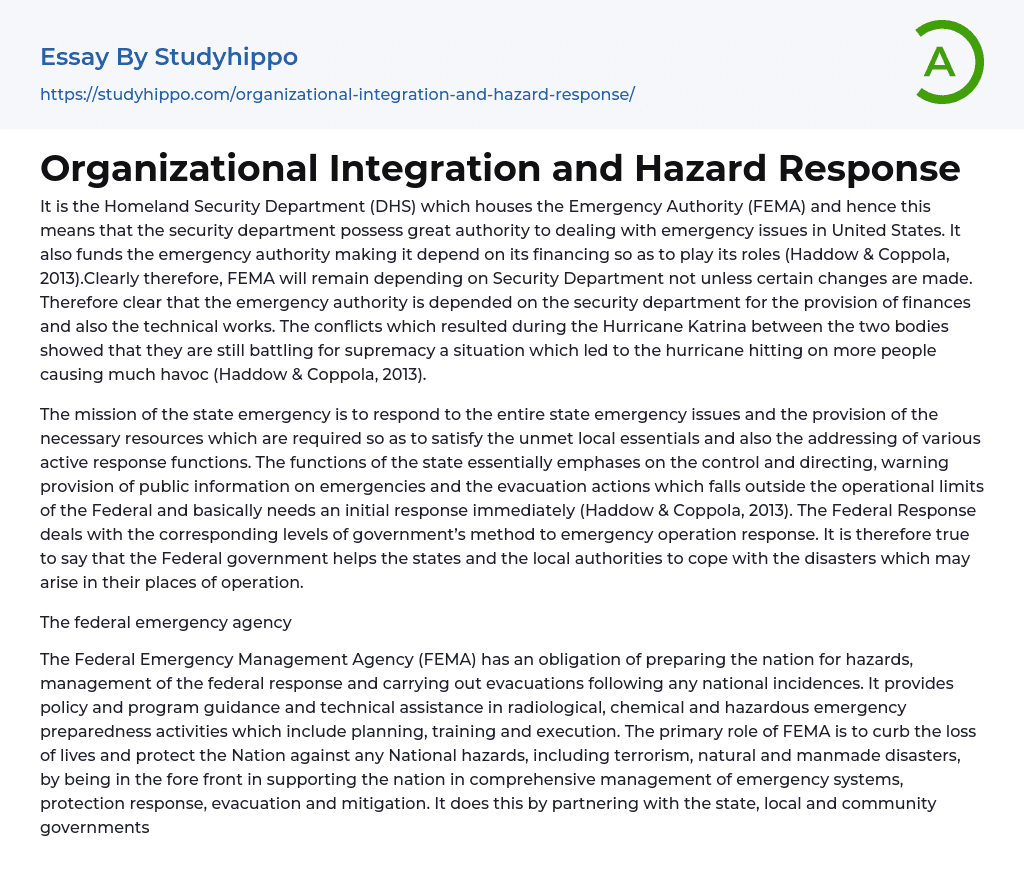

Organizational Integration and Hazard Response Essay Example
The Homeland Security Department (DHS) includes the Emergency Authority (FEMA), establishing the security department's significant authority in managing emergencies in the United States. It also provides funding for FEMA, making the emergency authority reliant on its financial support to carry out its responsibilities (Haddow ; Coppola, 2013). Consequently, FEMA depends on the Security Department for both financial and technical aid. The conflicts between these entities during Hurricane Katrina highlighted their ongoing power struggle, resulting in extensive damage and impact on a larger number of individuals (Haddow ; Coppola, 2013). The state emergency mission aims to address all emergency issues within the state by supplying necessary resources to meet local needs and fulfill various response functions.
The state is chiefly accountable for controlling and directing emergency response, offering public information on emergencies, and implementing evacuation actions that surpass the capabilities
...of the Federal government. The Federal Response entails a synchronized approach by the government to emergency operations, with assistance provided to states and local authorities in handling disasters in their regions. FEMA takes on the responsibility of preparing the nation for hazards, managing the federal response, and carrying out evacuations during national incidents. It provides guidance on policies and programs as well as technical support in radiological, chemical, and hazardous emergency preparedness activities including planning, training, and execution.
The Federal Emergency Management Agency (FEMA) has the primary goal of preventing loss of life and safeguarding the nation from a variety of national hazards, including terrorism, natural disasters, and manmade catastrophes. It achieves this by playing a leading role in supporting the country's comprehensive emergency management systems, protective responses, evacuations, and mitigation efforts. FEMA collaborates with state, local, and
community governments as well as non-governmental organizations to establish a nationwide emergency management system (Kapucu 2005).
The Department of Homeland Security's (DHS) Role
In order to address the ever-changing threats faced by Americans, the Department of Homeland Security (DHS) was established with the responsibility of protecting citizens from all forms of danger. The DHS has distributed its responsibilities across all states in America. Its mandate includes ensuring safety for the nation through various methods: consolidating authority over federal security operations related to transportation systems, territorial waters, and borders; overseeing federal government assistance in domestic disaster preparedness; and coordinating government disaster response through its central component FEMA.
Furthermore, the Department is responsible for leading the federal government’s efforts in preparation for and countering terrorism threats involving weapons of mass destruction such as chemical, biological, radiological, and nuclear weapons. Additionally, it works alongside other agencies including the CIA, NSA, FBI, and INS to safeguard America (Wise 2006).
Examples
An example of collaboration among federal, state, local, and private sectors occurred during Hurricane Katrina. Effective incident management played a crucial role in addressing this catastrophic event (Wise 2006).
A similar instance of joint coordination took place during Alabama's tornadoes and winds. FEMA and the U.S Department of Homeland Security collaborated with other agencies to mitigate the disaster's impact. The president also provided support by declaring a state of disaster for Alabama.
References
- Haddow, G., Bullock, J., ; Coppola, D. P. (2013). Introduction to emergency management. Butterworth-Heinemann.
- Kapucu, N. (2005). Interorganizational coordination in dynamic context: Networks in emergency response management. Connections, 26(2), 33-48.
- May, P.
J., Jochim, A.
E., ; Sapotichne, J. (2011). Constructing homeland security: An anemic policy regime. Policy Studies Journal, 39(2), 285-307.
R. (2006). Organizing for homeland security after Katrina: Is adaptive management what's missing? Public Administration Review, 302-318.
- Field essays
- Abolitionism essays
- Adam Smith essays
- American History essays
- American Revolution essays
- Ancient Egypt essays
- Articles Of Confederation essays
- Atlantic Slave Trade essays
- Aztec essays
- Benjamin Franklin essays
- Civil Rights Act of 1964 essays
- Civil Rights Movement essays
- Civil war essays
- Cleopatra essays
- French And Indian War essays
- Gettysburg essays
- Great Depression essays
- Hurricane Katrina essays
- Industrial Revolution essays
- Jamestown essays
- Manifest Destiny essays
- Mccarthyism essays
- Patrick Henry essays
- Pearl Harbor essays
- Pocahontas essays
- Prohibition essays
- Pyramids essays
- Salem Witch Trials essays
- Slavery essays
- The New Deal essays
- Thirteen Colonies essays
- Westward Expansion essays
- Afghanistan essays
- Africa essays
- America essays
- Asia essays
- Australia essays
- Caribbean essays
- City essays
- Developing Country essays
- Dubai essays
- Earthquake essays
- Europe essays
- Fracking essays
- Georgia essays
- Middle East essays
- Natural Disaster essays
- New Zealand essays
- North Korea essays
- South Korea essays



